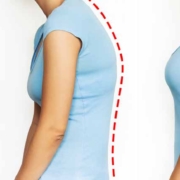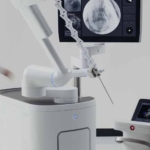The Posture of Life

by Paula Allia PT, DHSc, MTC, OCS
Posture is a term used loosely to describe the body’s position. In health and wellness, posture refers to the body’s anatomical position, particularly when it is against gravity. In utero, the fetus is positioned in a C curve. This position puts the majority of the flexor muscles in the front of the body in a shortened position while the extensor muscles, which are many of our postural muscles, are in a prolonged stretch.
At birth, the now infant has muscles that are weak and thus are limited in any actual purposeful movement.
Developmental milestones commence. Over time, the baby’s curiosity plays a role and the legs, back extend while the shoulder blades retract back taking the muscles and putting those once stretched extensor muscles in a shortened position to allow for strengthening to occur. As these muscles gain strength there is a bigger active range of motion setting the stage for precise purposeful movements.
Doing things against gravity contributes to the approximation of joints and thus allows the muscles to start to develop even more coordination with each other to create movements for desired activities. More strengthening and better alignment occurs which in turn allows for progressive postures and alignment. This progression continues throughout the developmental process.
In a standing position, if muscles coordinate and normal range of motion is possible, stationary posture is now actually easy. The head is up, shoulders are back, and so on down the chain to the feet. This is ideal. The problem is that there are usually imbalances somewhere. The adopted posters used with phones, iPads, and laptops cause many to sit slumped with the head forward and the back vulnerable to imbalances. Certainly, over time, these imbalances can occur from joint and muscle injuries or from repetitive or compromising postures.
Altered positions lead to the body compromising somewhere in the chain of motion. We know that the body may take the path of least resistance, falling into a slump. Then, the whole body has to adapt to this poor positioning and the once developed perfect postures now has loopholes. These seemingly easy alterations that happen unconsciously go unrecognized. The body falls back toward some of the premature postures. Thus, it is even more important to always strive to achieve the best positioning with good postural muscular awareness.
If good postural alignment cannot be achieved at rest, imagine how hard it is to be optimally positioned for movements and activities.
Normal stationary posture is important, but we are meant to be moving so postural awareness in movement is in fact most important. Do not take your body for granted. Like anything, it takes nurturing and awareness to flourish! The more abnormal movement patterns someone develops, the more difficult it is to maintain. If you look around and see the older individual, they start to revert back toward the position in which they were born.
It is never too late to improve your posturing and try to avoid falling backwards into poor postural habits. Keeping the right muscles strong and counteracting the repetitive patterns used everyday to maintain or regain strong position sense is ideal. Undo the bad things by resetting your muscles at the beginning and end of each day. Keep the extensors strong to offset faulty habits. If you need help getting to a better place, please call Fitness Together at (239) 263-9348 (335 14th Avenue South) and we can guide you in the right direction.




Leave a Reply
Want to join the discussion?Feel free to contribute!